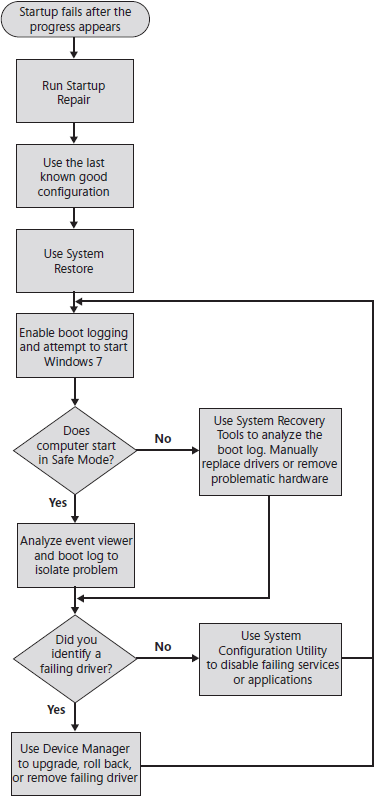Startup Troubleshooting After the Starting Windows Logo Appears
If your computer displays the graphical Starting Windows logo before failing, the Windows kernel was successfully loaded. Most likely, the startup failure is caused by a faulty driver or service.
Use the process illustrated in Figure below to identify and disable the failing software feature to allow Windows to start successfully. After Windows starts, you can perform further troubleshooting to resolve the problem with the feature if necessary. If the startup problem occurs immediately after updating or installing a startup application, try troubleshooting the startup application. For information about troubleshooting startup applications, see the section titled "How to Temporarily Disable Startup Applications and Processes" later in this tutorial.

The sections that follow describe each of these steps in more detail.
How to Run Startup Repair
Startup Repair can automatically fix many common startup problems, even if the problem occurs after the Starting Windows logo is displayed. Because Startup Repair is easy to use and has a very low likelihood of causing additional problems, it should be your first troubleshooting step. For detailed instructions, refer to the section titled "How to Run Startup Repair" earlier in this tutorial.
After running Startup Repair, attempt to start your computer normally and continue with the troubleshooting process only if Windows fails to start.
In this tutorial:
- Configuring Startup and Troubleshooting Startup Issues
- What is New with Windows Startup
- Boot Configuration Data
- BCD Stores
- System Recovery
- Windows Boot Performance Diagnostics
- Understanding the Startup Process
- Power-on Self Test Phase
- Initial Startup Phase
- Initial Startup Phase for BIOS Computers
- Initial Startup Phase for EFI Computers
- Windows Boot Manager Phase
- Windows Boot Loader Phase
- Kernel Loading Phase
- Control Sets
- Values for the Start Registry Entry
- Value Descriptions for Type Entries
- Other Registry Entries in the Servicename Subkeys
- Session Manager
- Logon Phase
- Important Startup Files
- How to Configure Startup Settings
- How to Use the Startup And Recovery Dialog Box
- How to Use the System Configuration Tool
- How to Use BCDEdit
- How to Interpret BCDEdit Output
- How to Back Up and Restore Settings
- How to Change the Default Operating System Entry
- How to Change the Boot Menu Time-Out
- How to Change the Order of Boot Manager Menu Items
- How to Create an Entry for Another Operating System
- How to Remove a Boot Entry
- How to View and Update Global Debugger Settings
- How to Remove the Windows 7 Boot Loader
- How to Configure a User Account to Automatically Log On
- How to Disable the Windows Startup Sound
- How to Speed Up the Startup Process
- The Process of Troubleshooting Startup
- Startup Troubleshooting Before the Starting Windows Logo Appears
- How to Start the System Recovery Tools
- How to Run Startup Repair
- How to Use BootRec.exe
- How to Diagnose Hardware Problems
- How to Use System Restore
- How to Manually Repair the Boot Sector
- How to Manually Update the BCD Registry File
- How to Manually Replace Files
- How to Reinstall Windows
- Startup Troubleshooting After the Starting Windows Logo Appears
- How to Restore the Last Known Good Configuration
- How to Enable Boot Logging
- How to Start in Safe Mode
- How to Identify Failing Drivers and Services
- How to Analyze Startup Problems in Safe Mode
- Event Viewer (Eventvwr.msc)
- System Information
- Error Reporting Service
- How to Use Device Manager to View or Change Resources
- How to Analyze Boot Logs
- How to Roll Back Drivers
- How to Temporarily Disable a Service
- Troubleshooting Startup Problems After Logon
- How to Temporarily Disable Startup Applications and Processes
- How to Disable Startup Applications Using the Shift Key
- How to Disable Startup Programs Using the System Configuration Utility
- How to Disable Startup Applications Configured Using Group Policy or Logon Scripts
- How to Permanently Disable Startup Applications and Processes
- Manually Remove the Entry
